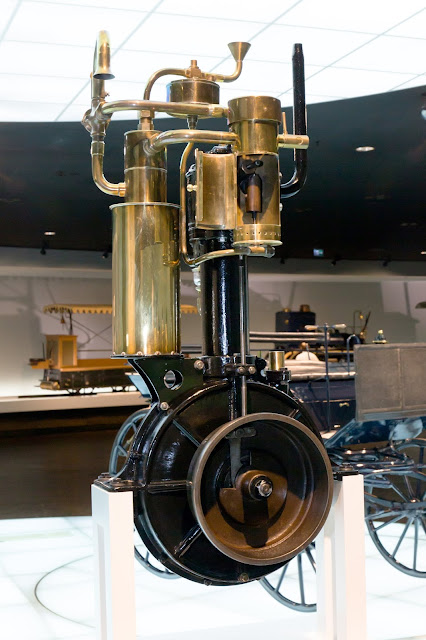Compact Power: The Internal Combustion Engine (ICE)
Along with the development of the bicycle, the internal combustion engine was most critical to developments in early automobile history. Credit for the ICE is normally given to Belgian inventor Etienne Lenoir (1822-1900), although his efforts followed a long succession of pioneering efforts going back to the 17thcentury and Christian Huygens use of gunpowder to drive pumps that supplied Versailles gardens with water.
 |
| Etienne Lenoir |
Others who tried to harness the explosion of gas in a cylinder were British inventors Robert Street, Samuel Brown, Lemuel Wellman Wright William Barnett; Philippe Lebon in France; and Eugenio Barsanti and Felice Matteucci, working on the problem in Italy between 1853 and 1857. [1]
 |
Living in France, Lenoir patented a two-stroke engine in 1860 that used illuminating gas (gas derived from heating coal in large retorts) that was ignited by a spark generated by a battery and coil. Lenoir’s engine was noisy and inefficient, and it tended to overheat. Used in stationary applications to power pumps and machines, some 250 were sold by 1865. And while the editor of Scientific American proclaimed in 1860 that with the coming of the Lenoir engine the Age of Steam was coming to an end, it took more than four decades before the ICE would eclipse the steam engine.16
In 1876, Nicholas Otto (1832-1891) developed a four-cycle “Silent Otto” engine (intake, compression, power, and exhaust), and Lenoir came up with a similar design during 1883 and 1884. Otto's "Silent" engine was only relatively quiet when compared to a precursor design. Believing that his design stratified the charge mixture and thus reduced the shock of the explosion, Otto based his improved technology on what might be regarded as bad science.
 |
| "Silent" Otto Engine |
Two engineers who had once worked for Otto at the Deutz Gas motor Factory, Gottleib Daimler (1834-1900) and Wilhelm Maybach (1846-1929), designed a 1.5 horsepower, 110 pound, 600 rpm “high speed engine” in 1885, and built several experimental vehicles between 1885 and 1889. Maybach, one of the most important engineer-inventors of this early period, designed the modern carburetor for mixing air and gasoline in 1893.17
 |
| 1885 Daimler High=Speed Engine |
 |
| 1886 Daimler Motor Coach |
In the meantime, Karl Benz (1844-1929) designed a two stroke engine in 1881 in his small shop located in Mannheim, Germany and began selling them in 1883. Because Deutz Co. patents had been cancelled in the courts in 1884 and 1886, Benz could design his own 4 cycle engine, and in placed that engine on a tricycle between 1885 and 1886. This 2/3 horse power vehicle with its unreliable ignition took wife Bertha Benz on the road trip from Manheim to Pforsheim and back in 1886, and was the basis a model placed on sale in 1888. Benz exhibited a design at the 1889 Paris Exhibition. and by 1893 he had constructed an improved four-wheel car with a three-horsepower engine that sold well and was fairly reliable. More than 100 Benz vehicles were sold by 1898. An early leader, Benz was soon passed technologically, especially by French manufacturers.
 |
| Benz factory in Mannheim Waldorf |
James Laux, in his book First Gear, characterizes in detail the French automobile industry before 1914.18According to Laux, Emile Constant Levassor was the key French inventor-engineer of the late nineteenth century European automobile industry., Levassor took Gottleib Daimler’s engine and placed it in the front of the vehicle where for the most part it has stayed to this day. Before Levassor’s untimely death, he proved the merits of his design as practical in the 1895 Paris-Bordeaux-Paris race.
At first, and for only a relatively short time, Paris was the center of the nascent global automobile industry. Perhaps this was due to excellent French roads or social, economic, or political factors that remain to be explicated and are currently discounted. James Flink has argued that the importance of Paris was accidental rather than a crystallization of a complex network of relationships that included German, French, and Belgian inventors and businessmen.19
The importance of the early French auto industry is reflected in the following chart20:
Year
|
Total Vehicles in Use
|
1899
|
1,672
|
1900
|
2,897
|
1901
|
5,386
|
1902
|
9,207
|
1903
|
12,984
|
1904
|
17,107
|
1905
|
21,543
|
1906
|
26,262
|
1907
|
31,286
|
1908
|
37,586
|
1908
|
46,000
|
While a number of entrepreneurs in England, America, and Germany were only beginning to catch up to the French by the end of the nineteenth century, there was a concurrent Darwinian-like competition among three rival technologies in terms of power–the ICE already mentioned, steam, and electricity. In the end the most economically efficient technology would prevail, but that was by no means clear to those living in 1900.
[1] Jean-Pierre Bardou, Jean-Jacques Chanaron, Patrick Fridenson, and James Laux, The Automobile Revolution: The Impact of an Industry. Chapel Hill, NC: University of North Carolina Press, 1982, pp. 4-6.








ReplyDeletehãng vé máy bay eva
đại lý vé máy bay đi mỹ
korean air booking
săn vé máy bay đi mỹ giá rẻ
săn vé máy bay giá rẻ đi canada
Nhung Chuyen Di Cuoc Doi
Ngau Hung Du Lich
Kien Thuc Du Lich